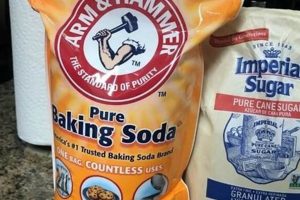The ability to govern the movement of a magnetic stirring element through user-designed and constructed means represents a specific approach to laboratory mixing. This methodology typically involves creating a device capable of rotating a magnet, which in turn drives a stirring bar placed inside a container holding a liquid solution. For example, a researcher might build a compact, battery-powered unit to maintain a homogenous mixture during a field experiment where commercial equipment is unavailable.
Precise management over stirring parameters allows for customization in applications requiring specific mixing rates or durations. This approach can offer cost savings for laboratories on a tight budget or provide a platform for experimentation with novel mixing techniques. Historically, the need for tailored solutions in scientific research has driven the development of innovative laboratory equipment.
The subsequent sections will explore the underlying principles, construction methods, and various applications of such self-made stirring systems, focusing on aspects such as motor selection, magnetic coupling, and speed regulation.
Essential Considerations for Self-Fabricated Magnetic Stirring Systems
The construction and utilization of self-fabricated magnetic stirring systems necessitate careful attention to design and operational parameters. The following guidelines provide essential considerations for ensuring effective and reliable performance.
Tip 1: Magnet Selection: Employ magnets with sufficient strength to ensure robust coupling with the stirring bar. Neodymium magnets are generally preferred due to their high magnetic field strength, but their susceptibility to corrosion should be considered in humid environments. Shielding or coating may be necessary.
Tip 2: Motor Specification: Choose a motor with appropriate torque and speed characteristics for the intended application. A motor that is too weak will be unable to drive the stirring bar effectively, particularly in viscous solutions. Conversely, excessive speed can lead to vortex formation and inefficient mixing.
Tip 3: Coupling Alignment: Precise alignment between the driving magnet and the stirring bar is critical for smooth and consistent operation. Misalignment can cause erratic movement, noise, and premature wear on the components. Implement methods to ensure accurate positioning during construction.
Tip 4: Speed Control Implementation: Incorporate a speed control mechanism to regulate the stirring rate. Pulse-width modulation (PWM) is a common and effective technique for controlling DC motor speed. A well-designed speed control circuit allows for precise adjustment of the mixing intensity.
Tip 5: Enclosure Material: Select an enclosure material that is chemically resistant to the solutions being stirred. Avoid materials that can react with or leach contaminants into the solution. Stainless steel or chemically inert plastics are often suitable choices.
Tip 6: Power Supply Considerations: Ensure that the power supply provides a stable and reliable voltage to the motor. Fluctuations in voltage can affect the stirring speed and potentially damage the motor. Consider using a regulated power supply.
Tip 7: Heat Dissipation: Motors can generate heat during operation. Provide adequate ventilation or heat sinking to prevent overheating, which can reduce motor lifespan and potentially pose a safety hazard.
Adherence to these guidelines will contribute to the creation of a functional and dependable stirring system. Careful planning and execution are essential for achieving the desired mixing performance and ensuring the longevity of the device.
The subsequent section will present example designs and case studies to illustrate practical implementations of the concepts discussed.
1. Motor Torque
Motor torque, within the context of a self-assembled magnetic stirring apparatus, directly governs the system’s capacity to overcome resistance and impart rotational motion to the stirring bar. Insufficient torque will impede the stirring bar’s movement, particularly in solutions exhibiting high viscosity or containing suspended solids. This deficiency compromises the uniformity of mixing, leading to inaccurate experimental results. For example, attempting to stir a thick polymer solution with a motor lacking sufficient torque will likely result in the stirring bar stalling or rotating erratically, leaving portions of the solution unmixed.
The selection of a motor with appropriate torque characteristics constitutes a critical design parameter. Torque requirements increase proportionally with solution viscosity, stirring bar size, and desired mixing speed. A DC motor with a gearbox can provide increased torque at lower speeds, offering a practical solution for stirring dense or viscous materials. Conversely, for low-viscosity solutions requiring rapid mixing, a higher-speed motor with lower torque may suffice. Quantitative analysis of solution rheology and careful consideration of these factors ensure effective mixing.
In summary, motor torque represents a fundamental performance determinant in a self-built magnetic stirring system. Underestimation of torque requirements leads to ineffective mixing, while overestimation introduces unnecessary power consumption and potential mechanical stress. A thorough understanding of the interplay between motor torque, solution properties, and stirring parameters is essential for successful design and operation, ensuring reliable and consistent experimental outcomes.
2. Magnet Strength
Magnet strength is a critical determinant of performance in a self-constructed magnetic stirring apparatus. The magnetic field generated by the driving magnet must be sufficient to overcome the forces resisting the rotation of the stirring bar within the solution. Insufficient magnetic strength results in slippage or decoupling, where the stirring bar fails to follow the rotation of the driving magnet. This leads to inconsistent mixing, particularly in viscous solutions or when using larger stirring bars. For instance, a weak magnet attempting to drive a large stirring bar in a glycerol solution will likely experience frequent decoupling, rendering the system ineffective.
The relationship between magnet strength, distance, and the material separating the driving magnet and the stirring bar is governed by the inverse square law. Increasing the distance or interposing a non-magnetic, but conductive, material (such as a metal plate) weakens the magnetic field experienced by the stirring bar. Therefore, careful consideration must be given to magnet placement and the materials used in the apparatus construction. Selecting a stronger magnet can compensate for these factors, but this increases cost and may necessitate more robust motor control circuitry. A practical application involves strategica
lly positioning the driving magnet as close as possible to the stirring bar, minimizing the intervening material’s thickness to maximize the magnetic coupling.
In conclusion, magnetic strength directly impacts the efficiency and reliability of a self-made stirring system. Optimal design requires a balance between magnet strength, physical separation, and the properties of the solutions being mixed. Understanding this relationship is essential for creating a functional and dependable apparatus capable of achieving consistent and reproducible mixing results. Failure to address this element leads to unreliable performance and negates the benefits of a customized stirring solution.
3. Speed Stability
Speed stability, in the context of a user-assembled magnetic stirring device, represents the consistency with which the stirring bar rotates at a designated rate. Variations in speed directly affect the reproducibility of experimental results. Unstable speeds can lead to inconsistent mixing, impacting reaction kinetics and homogeneity of solutions. For instance, in a titration experiment, fluctuating stirring speeds could alter the rate at which the titrant mixes, leading to erroneous endpoint determinations. Therefore, stable speed control is not merely a desirable feature but a fundamental requirement for generating reliable data.
Achieving stable speed requires careful consideration of several factors, including motor selection, power supply regulation, and feedback control mechanisms. Fluctuations in the power supply voltage can directly influence the motor’s rotational speed. Employing a regulated power supply mitigates this issue, ensuring a consistent voltage delivery to the motor. Furthermore, incorporating a feedback control loop, such as a PID (proportional-integral-derivative) controller, allows the system to actively compensate for deviations from the set speed. A sensor monitors the stirring bar’s rotation, and the controller adjusts the motor’s power input to maintain the desired speed, even under varying load conditions, like changing solution viscosity.
In summary, speed stability is an indispensable component of a functional magnetic stirring device. It directly impacts the accuracy and reproducibility of experimental outcomes. Achieving speed stability necessitates a holistic approach encompassing stable power delivery, appropriate motor selection, and potentially, the implementation of a feedback control system. Failure to prioritize speed stability undermines the purpose of constructing a custom stirring apparatus, rendering it unsuitable for applications demanding precise control and consistent results.
4. Coupling Alignment
Precise coupling alignment is paramount to the effective operation of any magnetic stirring apparatus, particularly within the realm of user-constructed designs. Misalignment introduces inefficiencies, instability, and potential component failure, directly impacting the system’s ability to achieve consistent and reliable mixing.
- Reduced Torque Transmission
Suboptimal alignment between the driving magnet and the stirring bar reduces the efficiency of torque transfer. A misaligned magnet generates a non-uniform magnetic field, resulting in a weaker coupling force. This necessitates higher motor power to achieve the same stirring rate, potentially overloading the motor or leading to inconsistent mixing, particularly in viscous solutions. An example includes a system where the driving magnet is slightly offset; the stirring bar may exhibit jerky, uneven rotation, impacting the homogeneity of the solution.
- Increased Vibration and Noise
Misalignment induces vibrations as the stirring bar attempts to follow the uneven magnetic field. These vibrations generate noise and can contribute to instability, potentially causing the stirring vessel to move or even tip over. Furthermore, sustained vibration accelerates wear and tear on the bearings and other mechanical components. Consider a situation where the driving magnet’s axis is not perfectly perpendicular to the stirring plane; the resulting vibrations can be audibly distracting and mechanically damaging over time.
- Premature Component Wear
The uneven forces exerted due to misalignment place undue stress on both the driving magnet and the stirring bar. This leads to accelerated wear and tear, shortening the lifespan of these components. The constant friction and stress can also damage the bearings and other supporting structures, requiring more frequent maintenance and replacements. For instance, a system with significant misalignment may exhibit visible wear on the stirring bar coating or the surface of the driving magnet after prolonged use.
- Inconsistent Mixing Performance
The ultimate consequence of poor coupling alignment is inconsistent mixing performance. The non-uniform magnetic field and erratic stirring bar movement prevent the solution from being thoroughly mixed, leading to inaccurate experimental results or suboptimal reaction conditions. The lack of homogeneity can invalidate experimental findings and necessitate repeated trials. Visualize a scenario where a reagent is added to a misaligned stirring system; portions of the solution may remain unmixed, resulting in localized concentration gradients and skewed reaction outcomes.
These facets underscore the criticality of achieving and maintaining proper coupling alignment in a user-built magnetic stirring device. Addressing this element proactively is essential for ensuring reliable operation, extending component lifespan, and achieving consistent mixing performance, ultimately contributing to the accuracy and reproducibility of experimental results. Neglecting alignment can render the entire system ineffective, regardless of the sophistication of other design elements.
5. Enclosure Material
The selection of an appropriate enclosure material directly impacts the functionality, safety, and longevity of a self-constructed magnetic stirring apparatus. The enclosure provides structural support, protects internal components, and may also serve as a barrier against chemical exposure.
- Chemical Resistance
The enclosure material must exhibit resistance to the chemicals used in the stirring process. Exposure to corrosive substances can lead to degradation of the enclosure, compromising its structural integrity and potentially releasing contaminants into the solution. For instance, using an enclosure made of standard steel when stirring hydrochloric acid would result in rapid corrosion. Materials such as polypropylene, PTFE (Teflon), or stainless steel are often selected for their superior chemical inertness in corrosive environments. Careful consideration of the chemicals used is paramount.
- Thermal Stability
The enclosure should maintain its structural integrity and properties within the operating temperature range. Some reactions generate heat, which can deform or melt enclosures made of unsuitable materials. Furthermore, excessive heat within the enclosure can damage electronic components, such as the motor and control circuitry. Materials like aluminum, with goo
d heat conductivity, can help dissipate heat, while high-temperature plastics can withstand elevated temperatures without deforming. The expected temperature range of operation should inform material selection. - Electromagnetic Interference (EMI) Shielding
In sensitive applications, the enclosure may need to provide shielding against electromagnetic interference. The motor and control circuitry can generate EMI, which can disrupt nearby electronic equipment or introduce noise into experimental data. Metal enclosures, particularly those made of steel or aluminum, effectively block EMI. If a plastic enclosure is desired, conductive coatings or embedded metal meshes can provide EMI shielding. The need for EMI shielding depends on the operating environment and the sensitivity of surrounding equipment.
- Mechanical Robustness
The enclosure must be sufficiently robust to withstand physical impacts and stresses encountered during normal use. A flimsy enclosure can crack or break, exposing internal components and potentially creating a safety hazard. Materials such as thick-walled plastics, steel, or aluminum offer greater mechanical strength. The expected usage environment and potential for accidental impacts should influence the choice of enclosure material. For example, a stirring device used in a mobile laboratory setting would require a more robust enclosure than one used in a stationary setting.
The interplay of these factors dictates the optimal selection of enclosure material for a given self-fabricated magnetic stirring system. A thorough evaluation of the operating environment, chemical compatibility, and performance requirements is essential for ensuring the safety, reliability, and longevity of the device. Failure to adequately address these considerations can lead to premature failure of the system and compromise experimental results.
6. Power Regulation
Power regulation represents a critical aspect of self-constructed magnetic stirring systems, ensuring consistent and predictable operation. Inadequate power regulation can lead to fluctuations in motor speed, directly affecting mixing efficiency and the reproducibility of experimental results. A stable power supply is thus fundamental to reliable performance.
- Voltage Stabilization
Voltage stabilization is paramount for maintaining consistent motor speed. Variations in input voltage can cause corresponding fluctuations in the motor’s rotational speed, undermining the precision of the stirring process. For instance, if the power supply voltage drops, the motor speed decreases, potentially leading to incomplete mixing or inaccurate reaction kinetics. Implementing a voltage regulator, such as a linear regulator or a switching regulator, mitigates these fluctuations, providing a stable voltage to the motor regardless of input variations. This ensures a consistent stirring rate, essential for repeatable experiments.
- Current Limiting
Current limiting protects the motor and other components from damage due to excessive current draw. Motors can draw a surge of current during startup or when encountering increased resistance, potentially leading to overheating or component failure. A current limiting circuit restricts the maximum current flowing to the motor, preventing damage and extending the lifespan of the system. For example, a sudden increase in solution viscosity could cause the motor to draw more current; a current limiting circuit would prevent the motor from burning out. This safeguard is crucial for reliable long-term operation.
- Speed Control Implementation
Precise speed control is often achieved through power regulation techniques. Methods such as pulse-width modulation (PWM) allow for fine-grained adjustment of the motor’s average power, enabling precise control over the stirring rate. PWM involves rapidly switching the power supply on and off, varying the duty cycle to control the motor’s speed. This allows for smooth and accurate speed adjustments, crucial for applications requiring specific mixing rates. For instance, a researcher might use PWM to slowly increase the stirring speed to prevent splashing or vortex formation.
- Filtering and Noise Reduction
Power regulation circuits often incorporate filtering components to reduce electrical noise that can interfere with the motor’s operation or other electronic components. Noise in the power supply can cause erratic motor behavior or introduce errors in sensor readings. Filtering circuits, such as capacitors and inductors, smooth out the voltage and current, minimizing noise and ensuring stable operation. This is particularly important in sensitive experiments where even small fluctuations in stirring speed can affect the results. A well-designed power regulation circuit minimizes noise, contributing to a more reliable and accurate stirring system.
These elements of power regulation collectively ensure stable and controlled operation of a user-built magnetic stirring device. Consistent voltage, limited current, precise speed control, and noise reduction contribute to a reliable system capable of delivering reproducible results. The attention afforded to power regulation directly correlates with the accuracy and dependability of the stirring apparatus, making it a critical consideration in the design and construction process.
7. Vibration Dampening
Vibration dampening plays a crucial role in the effective operation of a self-constructed magnetic stirring apparatus. Excessive vibrations can negatively impact mixing efficiency, introduce noise, and compromise the structural integrity of the device. Implementing effective vibration dampening techniques is therefore essential for ensuring reliable and consistent performance.
- Stability Enhancement
Vibration dampening directly contributes to the stability of the stirring apparatus. Excessive vibrations can cause the stirring vessel to move or even tip over, particularly when mixing at higher speeds or with viscous solutions. Implementing dampening measures, such as using rubber feet or mounting the motor on a vibration-absorbing pad, minimizes these movements. A stable platform ensures consistent mixing and prevents accidental spills. For instance, a stirring apparatus used on a lab bench with inherent vibrations benefits significantly from dampening, preventing the vessel from “walking” across the surface.
- Noise Reduction
Vibrations generate unwanted noise, which can be distracting and disruptive in a laboratory environment. Dampening materials absorb and dissipate vibrational energy, reducing the amplitude of sound waves produced by the apparatus. Using a heavy base or lining the enclosure with sound-absorbing foam can effectively minimize noise pollution. Consider a scenario where multiple stirring devices are operating simultaneously; effective vibration dampening minimizes the overall noise level, creating a more comfortable and productive work environment.
- Component Protection
Vibrations can accelerate wear and tear on the mechanical and electronic components of the stirring apparatus. Constant shaking can loosen connections, damage bearings, and reduce the lifespan of the motor. Implementing vibration dampening minimizes these stresses, protecting the components and extendin
g the overall lifespan of the device. For example, mounting the motor on vibration isolators reduces the transmission of vibrations to the supporting structure, preventing premature failure of the motor bearings. - Improved Mixing Efficiency
While seemingly counterintuitive, excessive vibrations can actually hinder mixing efficiency. If the stirring bar is bouncing or moving erratically due to vibrations, it disrupts the intended flow patterns and reduces the effectiveness of the mixing process. Dampening vibrations stabilizes the stirring bar’s movement, ensuring a smooth and consistent rotation that promotes thorough mixing. Imagine a highly viscous solution being stirred with a vibrating apparatus; the stirring bar might skip and jump, failing to create the desired vortex and leaving portions of the solution unmixed.
In conclusion, the implementation of vibration dampening techniques is essential for optimizing the performance and reliability of a user-constructed magnetic stirring apparatus. By enhancing stability, reducing noise, protecting components, and improving mixing efficiency, vibration dampening contributes to a more effective and dependable stirring system. These factors collectively reinforce the importance of vibration dampening for any application requiring precise and consistent mixing.
Frequently Asked Questions
This section addresses common inquiries regarding the design, construction, and operation of self-assembled magnetic stirring devices. These responses aim to clarify potential challenges and provide guidance for optimal performance.
Question 1: What magnet strength is minimally acceptable for stirring viscous solutions?
The required magnetic strength directly correlates with solution viscosity, stirring bar size, and distance between the driving magnet and stirring bar. Empirical testing is often necessary to determine the optimal magnet strength for a specific application. Neodymium magnets are generally preferred due to their high magnetic field strength, but alternative materials may suffice for low-viscosity solutions.
Question 2: Can standard DC motors be used without speed control circuitry?
While a DC motor may rotate without speed control, stable and repeatable stirring requires a regulated power supply and ideally, a feedback control loop. Without such control, variations in line voltage or load can significantly impact stirring speed, compromising experimental accuracy.
Question 3: Is it acceptable to 3D-print the enclosure for a stirring device?
3D-printed enclosures are acceptable, provided the material is chemically compatible with the solutions being stirred and can withstand the operating temperature range. Ensure adequate structural integrity and consider the need for electromagnetic interference (EMI) shielding, which may require conductive coatings or inserts.
Question 4: What is the best method for aligning the driving magnet with the stirring bar?
Precise alignment is crucial. A common technique involves using a jig or fixture to ensure the driving magnet’s axis of rotation is perfectly parallel to the plane of the stirring bar. Visual inspection and fine adjustments are often necessary to minimize vibrations and maximize torque transmission.
Question 5: How is motor torque calculated for a specific stirring application?
Calculating motor torque requires considering solution viscosity, stirring bar dimensions, and desired stirring speed. Rheological measurements can provide quantitative data on solution viscosity. Online calculators and motor datasheets can then be used to estimate the required torque. Safety factors should be included to account for variations in solution properties and potential increases in viscosity during the stirring process.
Question 6: What are the safety considerations when building a self-fabricated magnetic stirrer?
Safety precautions include selecting chemically resistant enclosure materials, ensuring proper electrical insulation, and providing adequate ventilation to prevent motor overheating. Appropriate personal protective equipment (PPE) should be used when handling chemicals and operating the device. Overcurrent protection and emergency shut-off mechanisms are recommended.
These answers address some frequently encountered issues. Thorough planning and attention to detail are critical for building a safe, reliable, and effective stirring system.
The following section will explore specific applications of these stirring systems across diverse fields of study.
Conclusion
The preceding discussion has illuminated the multifaceted aspects of user-designed magnetic stirring systems. Key considerations encompass magnet strength, motor characteristics, speed regulation, coupling alignment, enclosure material selection, power management, and vibration mitigation. Rigorous attention to each of these elements is essential for constructing an apparatus capable of delivering consistent, reliable, and reproducible results.
The capacity to customize laboratory equipment, as exemplified by the principles of stir bar control diy magnetic stir, promotes innovation and resourcefulness in scientific endeavors. Continued exploration and refinement of these techniques will contribute to advancements across diverse research domains, fostering a culture of ingenuity and self-sufficiency within the scientific community.







